 Iron Casting 101
Iron Casting 101
Iron casting is a manufacturing process in which a molten material is poured into a mold, which contains a hollow cavity of the desired shape, and then allowed to solidify. The solidified part is also known as a casting, which is ejected or broken out of the mold to complete the process. Casting materials are usually metals or various cold setting materials that cure after mixing two or more components together; examples are epoxy, concrete, plaster and clay. Iron casting is most often used for making complex shapes that would be otherwise difficult or uneconomical to make by other methods.
Iron Casting Methods:
Metal
Metal casting is one of the most common casting processes. Metal patterns are more expensive but are more dimensionally stable and durable. Metallic patterns are used where repetitive production of castings is required in large quantities.
Plaster, Concrete, And Resin
Plaster and other chemical curing materials such as concrete and plastic resin may be cast using single-use waste molds as noted above, multiple-use ‘piece’ molds, or molds made of small rigid pieces or of flexible material such as latex rubber (which is in turn supported by an exterior mold). When casting plaster or concrete, the material surface is flat and lacks transparency. Often topical treatments are applied to the surface. For example, painting and etching can be used in a way that give the appearance of metal or stone. Alternatively, the material is altered in its initial casting process and may contain colored sand so as to give an appearance of stone.
By casting concrete, rather than plaster, it is possible to create sculptures, fountains, or seating for outdoor use. A simulation of high-quality marble may be made using certain chemically-set plastic resins (for example epoxy or polyester) with powdered stone added for coloration, often with multiple colors worked in. The latter is a common means of making washstands, washstand tops and shower stalls, with the skilled working of multiple colors resulting in simulated staining patterns as is often found in natural marble or travertine.
Sand Casting
Sand casting is one of the most popular and simplest types of casting, and has been used for centuries. Sand casting allows for smaller batches than permanent mold casting and at a very reasonable cost. Not only does this method allow manufacturers to create products at a low cost, but there are other benefits to sand casting, such as very small-size operations. From castings that fit in the palm of your hand to train beds (one casting can create the entire bed for one rail car), it can all be done with sand casting. Sand casting also allows most metals to be cast depending on the type of sand used for the molds.
Sand casting requires a lead time of days, or even weeks sometimes, for production at high output rates (1–20 pieces/hr-mold) and is unsurpassed for large-part production. Green (moist) sand has almost no part weight limit, whereas dry sand has a practical part mass limit of 12,000 lbs. The sand is bonded together using clays, chemical binders, or polymerized oils (such as motor oil). Sand can be recycled many times in most operations and requires little maintenance.
Casting Iron Foundry Capabilities
At our casting iron foundry, we are committed to maintaining the rich heritage of iron craftsmanship, blending traditional techniques with modern technology to produce superior quality castings. Our foundry specializes in sand casting, a versatile and economical method that suits a wide range of production scales—from small, intricate components to massive industrial parts such as railcar beds. Each project benefits from our expertise in handling different types of iron, including gray iron and ductile iron, ensuring that every casting meets the exacting standards required by diverse industries. Our foundry’s robust capabilities make us a leader in producing iron castings for applications in automotive, construction, and heavy machinery sectors.
Expertise in Iron Casting at Our Foundry
As a leading casting iron foundry, we offer extensive services from design consultation to final production, ensuring that each phase of the casting process is executed with precision. Utilizing both green sand and dry sand casting techniques, our facility manages to keep production costs low while maintaining high flexibility in terms of production volume and part complexity. The advanced metallurgical testing and quality assurance processes at our foundry guarantee that each iron casting delivered is of the highest durability and performance standards, making us a trusted partner in the foundry industry.
 Iron Casting 101
Iron Casting 101